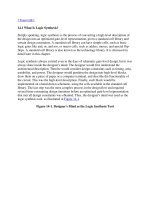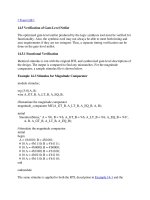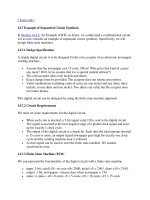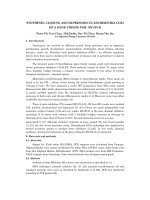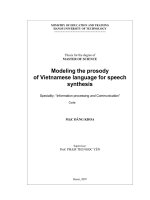Wiley verilog coding for logic synthesis 2003
Bạn đang xem bản rút gọn của tài liệu. Xem và tải ngay bản đầy đủ của tài liệu tại đây (1.28 MB, 334 trang )
Verilog Coding for
Logic Synthesis
Verilog Coding for
Logic Synthesis
WENG FOOK LEE
A JOHN WILEY & SONS, INC., PUBLICATION
Copyright © 2003 by John Wiley & Sons, Inc. All rights reserved.
Published by John Wiley & Sons, Inc., Hoboken, New Jersey.
Published simultaneously in Canada.
No part of this publication may be reproduced, stored in a retrieval system, or transmitted in
any form or by any means, electronic, mechanical, photocopying, recording, scanning, or
otherwise, except as permitted under Section 107 or 108 of the 1976 United States Copyright
Act, without either the prior written permission of the Publisher, or authorization through
payment of the appropriate per-copy fee to the Copyright Clearance Center, Inc., 222
Rosewood Drive, Danvers, MA 01923, 978-750-8400, fax 978-750-4470, or on the web at
www.copyright.com. Requests to the Publisher for permission should be addressed to the
Permissions Department, John Wiley & Sons, Inc., 111 River Street, Hoboken, NJ 07030, (201)
748-6011, fax (201) 748-6008, e-mail:
Limit of Liability/Disclaimer of Warranty: While the publisher and author have used their best
efforts in preparing this book, they make no representations or warranties with respect to the
accuracy or completeness of the contents of this book and specifically disclaim any implied
warranties of merchantability or fitness for a particular purpose. No warranty may be created
or extended by sales representatives or written sales materials. The advice and strategies
contained herein may not be suitable for your situation. You should consult with a professional
where appropriate. Neither the publisher nor author shall be liable for any loss of profit or any
other commercial damages, including but not limited to special, incidental, consequential, or
other damages.
For general information on our other products and services please contact our Customer
Care Department within the U.S. at 877-762-2974, outside the U.S. at 317-572-3993 or
fax 317-572-4002.
Wiley also publishes its books in a variety of electronic formats. Some content that appears in
print, however, may not be available in electronic format.
Library of Congress Cataloging-in-Publication Data:
Printed in the United States of America.
10 9 8 7 6 5 4 3 2 1
Dedicated to my mother
for all her sacrifices.
Contents
Table of Figures
xi
Table of Examples
xvii
List of Tables
xxi
Preface
xxiii
Acknowledgments
xxv
Trademarks
xxvi
1 Introduction
1
2 Asic Design Flow
3
2.1
2.2
2.3
2.4
2.5
2.6
2.7
2.8
2.9
Specification
RTL Coding
2.2.1 Types of Verilog Code: RTL, Behavioral, and
Structural
Test Bench and Simulation
Synthesis
Prelayout Timing Analysis
APR
Back Annotation
Post layout Timing Analysis
Logic Verification
3 Verilog Coding
3.1
Introduction to Basic Verilog Concepts
3.1.1 Verilog Syntax
3
5
6
6
9
10
11
12
13
14
16
16
16
vii
viii
CONTENTS
3.2
3.3
3.4
3.1.2 Comments
3.1.3 Numbers
3.1.4 Verilog Data Type
3.1.5 Signal Strength
Verilog Gate-Level Primitives
User-Defined Primitives
3.3.1 Combinational UDP
3.3.2 Sequential UDP
Concurrent and Sequential Statements
4 Coding Style: Best-Known Method for Synthesis
4.1
4.2
4.3
Naming Convention
Design Partitioning
Clock
4.3.1 Internally Generated Clock
4.3.2 Gated Clock
4.4 Reset
4.4.1 Asynchronous Reset
4.4.2 Synchronous Reset
4.5 Timing Loop
4.6 Blocking and Nonblocking Statement
4.7 Sensitivity List
4.8 Verilog Operators
4.8.1 Conditional Operators
4.8.2 Bus Concatenation Operator
4.8.3 Shift Operator
4.8.4 Arithmetic Operator
4.8.5 Division Operator
4.8.6 Modulus Operator
4.8.7 Logical Operator
4.8.8 Bitwise Operator
4.8.9 Equality Operator
4.8.10 Reduction Operator
4.8.11 Relational Operator
4.9 Latch Inference
4.10 Memory Array
4.11 State Machine Design
4.11.1 Intelligent Traffic Control System
5 Design Example of Programmable Timer
5.1
5.2
Programmable Timer Design Specification
Microarchitecture Definition for Programmable Timer
17
17
19
25
27
34
35
37
40
41
41
43
44
46
47
51
51
52
53
54
66
68
68
69
71
78
85
92
100
105
112
115
117
121
127
132
133
151
151
153
CONTENTS
5.3
5.4
5.5
Flow Diagram Definition for Programmable Timer
Verilog Code for Programmable Timer
Synthesizable Verilog Code for Programmable Timer
6 Design Example of Programmable Logic Block for Peripheral
Interface
6.1
6.2
6.3
6.4
6.5
6.6
Programmable Logic Block for Peripheral Interface
Design Specification
Mode of Operation for Programmable Logic Block for
Peripheral Interface
6.2.1 Mode 0 Operation
6.2.2 Mode 1 Operation
6.2.3 Mode 2 Operation
Microarchitecture Definition for Programmable Peripheral
Interface
Flow Diagram Definition for Programmable Peripheral
Interface
Synthesizable Verilog Code for Programmable Peripheral
Interface
Simulation for Programmable Peripheral Interface Design
6.6.1
6.6.2
6.6.3
6.6.4
6.6.5
6.6.6
6.6.7
6.6.8
6.6.9
6.6.10
6.6.11
Simulation for Mode 0 Operation with PortA, PortB,
and PortC as input and Output
Simulation for Mode 0 Operation with PortA, PortB,
and PortC Lower as Input and PortC Upper as
Output
Simulation for Mode 0 Operation with PortA, PortB,
and PortC Upper as Input and PortC Lower as Output
Simulation for Writing and Reading Data from
STATUS and CWR Register
Simulation for Mode 1 Operation with PortA and
PortB as Strobed Input
Simulation for Mode 1 Operation with PortA as
Strobed Input and PortB as Strobed Output
Simulation for Mode 1 Operation with PortA as
Strobed Output and PortB as Strobed Input
Simulation for Mode 1 Operation with PortA and
PortB as Strobed Output
Simulation for Mode 2 Operation with PortA as
Strobed I/O and PortB as Input
Simulation for Mode 2 Operation with PortA as
Strobed I/O and PortB as Output
Simulation for Mode 1 Operation with PortA and
PortB as Strobed Input and STATUS Register
Disabled
ix
155
161
175
181
182
185
185
187
188
189
191
213
234
235
240
245
249
253
257
262
267
272
277
282
x
CONTENTS
6.6.12 Simulation for Mode 2 Operation with PortA as
Strobed I/O and PortB as Output and STATUS
Register Disabled
Appendix
Appendix A.1. two-bit by two-bit adder
Appendix A.2. two-bit by two-bit subtractor
Appendix A.3. four-bit by four-bit multiplier
287
293
293
295
297
Glossary
305
Bibliography
307
Index
308
Table of Figures
Figure 2.1
Figure 2.2
Diagram Showing an ASIC Design Flow
Diagram Indicating Step 1 of an ASIC Design Flow:
Specification
Figure 2.3 Diagram Showing the Definition of Architecture and
Micro Architecture
Figure 2.4 Diagram Indicating Step 2 of an ASIC Design Flow:
RTL Coding
Figure 2.5 Diagram Indicating Step 3 of an ASIC Design Flow:
Testbench and Simulation
Figure 2.6 Diagram Indicating Step 4 of an ASIC Design Flow:
Synthesis
Figure 2.7 Diagram Indicating Step 5 of an ASIC Design Flow:
Pre Layout Timing Analysis
Figure 2.8 Diagram Indicating Step 6 of an ASIC Design Flow:
Auto Place & Route (APR)
Figure 2.9 Diagram Indicating Step 7 of an ASIC Design Flow:
Back Annotation
Figure 2.10 Diagram Indicating Step 8 of an ASIC Design Flow:
Post Layout Timing Analysis
Figure 2.11 Diagram Indicating Step 9 of an ASIC Design Flow:
Logic Verification
Figure 4.1 Diagram Showing Two Sub-modules Connected on a
Fullchip Level
Figure 4.2 Diagram Showing a Fullchip Level of Global Clock
Interconnect
Figure 4.3 Diagram Showing Ideal Connectivity of Clock Signal
in a Design
Figure 4.4 Diagram Showing an Output Flip-flop Driving
Another Flip-flop
4
4
5
6
8
9
11
12
13
14
15
42
44
45
46
xi
xii
TABLE OF FIGURES
Figure 4.5
Figure 4.6
Figure 4.7
Figure 4.8
Figure 4.9
Figure 4.10
Figure 4.11
Figure 4.12
Figure 4.13
Figure 4.14
Figure 4.15
Figure 4.16
Figure 4.17
Figure 4.18
Figure 4.19
Figure 4.20
Figure 4.21
Figure 4.22
Figure 4.23
Figure 4.24
Figure 4.25
Figure 4.26
Figure 4.27
Diagram Showing a Gated Clock Driving a Flip-flop
Diagram Showing Signal Gated Driving Clock of 32
Flip-flops
Diagram Showing Multiple Gated Signal to Drive 32
Flip-flops
Diagram Showing a Design with an Asynchronous
Reset Flip-flop
Diagram Showing a Design with a Synchronous Reset
Flip-flop
Diagram Showing a Design with Timing Loop
Diagram Showing Simulation Results of Verilog Code
in Example 4.8
Diagram Showing Simulation Results of Verilog Code
in Example 4.9
Diagram Showing Simulation Results of Verilog Code
in Example 4.10
Diagram Showing Simulation Results of Verilog Code
in Example 4.12
Diagram Showing Simulation Results of Verilog Code
in Example 4.13
Diagram Showing Simulation Results of Verilog Code
in Example 4.14
Diagram Showing Synthesized Logic for Module
“conditional”
Diagram Showing Synthesized Logic for Module
“shift_left”
Diagram Showing Synthesized Logic for Module
“shift_right”
Diagram Showing Synthesized Logic for Module
“addition”
Diagram Showing Synthesized Logic for Module
“subtraction”
Diagram Showing Synthesized Logic for Module
“multiplication”
Diagram Showing Synthesized Logic for Design
Module “division”
Diagram Showing Synthesized Logic for Design
Module “modulus”
Diagram Showing Synthesized Logic for Verilog Code
Module “logical”
Diagram Showing Synthesized Logic for Verilog Code
Module “bitwise”
Diagram Showing Synthesized Logic for Verilog Code
Module “logicequal”
47
49
49
52
53
54
58
58
59
59
63
64
70
72
75
79
81
83
86
94
100
107
113
TABLE OF FIGURES
Figure 4.28 Diagram Showing Synthesized Logic for Verilog Code
Module “reduction”
Figure 4.29 Diagram Showing Simulation Results of Verilog
Testbench Module “relational_tb”
Figure 4.30 Diagram Showing Synthesized Logic for Module
“latch_infer”
Figure 4.31 Diagram Showing Synthesized Logic of Module
“latch_noninfer”
Figure 4.32 Diagram Showing Synthesized Logic for Module
“case_infer”
Figure 4.33 Diagram Showing Synthesized Logic for Module
“case_uninfer_diff”
Figure 4.34 Diagram Showing Synthesis Representation of a One
Bit Memory Cell
Figure 4.35 Diagram Showing Simulation Waveform for Verilog
Testbench Module “memory_tb”
Figure 4.36 Diagram Showing an Interchange Junction Traffic Light
Figure 4.37 Diagram Showing Possible Pass Scenario Whereby
S1_S3 is GREEN
Figure 4.38 Diagram Showing Possible Pass Scenario Whereby
S2_S4 is GREEN
Figure 4.39 Diagram Showing Possible Pass Scenario Whereby
S1T_S3T is GREEN
Figure 4.40 Diagram Showing Possible Pass Scenario Whereby
S2T_S4T is GREEN
Figure 4.41 Diagram Showing Interface Signals for Traffic Light
Controller
Figure 4.42 State Diagram for Traffic Light State Machine
Controller
Figure 4.43 Diagram Showing Simulation Results of Testbench
Module state_machine_tb
Figure 5.1 Diagram Showing Bits of Control Word Register
Figure 5.2 Diagram Showing the Interface Signals for
Programmable Timer Design
Figure 5.3 Micro-architectural Block Diagram of the
Programmable Timer Design
Figure 5.4 Flow Diagram for Loading Data Into Programmable
Timer and Writing Data Into Control Word Register
Figure 5.5 Flow Diagram for Reset of Programmable Timer
Figure 5.6 Flow Diagram for Mode 0 Operation
Figure 5.7 Flow Diagram for Mode 1 Operation
Figure 5.8 Flow Diagram for Mode 2 Operation
Figure 5.9 Diagram Showing Decoding of Control Word
Register and Counter for Output Generation
xiii
115
120
122
124
125
126
128
131
133
134
135
135
136
136
138
149
152
154
154
155
156
157
158
159
160
xiv
TABLE OF FIGURES
Figure 5.10 Diagram Showing Simulation Results of Verilog
Testbench for Mode 0
Figure 5.11 Diagram Showing Simulation Results of Verilog
Testbench for Mode 1
Figure 5.12 Diagram Showing Simulation Results of Verilog
Testbench for Mode 2
Figure 6.1 Diagram Showing Interface Signals of PLB
Figure 6.2 Diagram Showing Functionality of Each Bit in CWR
Register
Figure 6.3 Diagram Showing Functionality of Each Bit in
STATUS Register
Figure 6.4 Diagram Showing Interface Signals in Mode 1
Operation with PortA and PortB as Strobed Input
Port
Figure 6.5 Diagram Showing Interface Signals in Mode 1
Operation with PortA as Strobed Input Port and
PortB as Strobed Output Port
Figure 6.6 Diagram Showing Interface Signals in Mode 1
Operation with PortA as Strobed Output Port and
PortB as Strobed Input Port
Figure 6.7 Diagram Showing Interface Signals in Mode 1
Operation with PortA and PortB as Strobed Output
Port
Figure 6.8 Diagram Showing Interface Signals in Mode 2
Operation with PortA as Strobed IO and PortB as
Output Port
Figure 6.9 Diagram Showing Interface Signals in Mode 2
Operation with PortA as Strobed IO and PortB as
Input Port
Figure 6.10 Micro-architectural Block Diagram of the
Programmable Peripheral Interface Design
Figure 6.11 Flow Diagram for Writing Data to CWR Register and
STATUS Register
Figure 6.12 Flow Diagram for Reading Contents of CWR Register
and STATUS Register
Figure 6.13 Flow Diagram for Latching Data From data Bus Onto
latch_data Bus
Figure 6.14 Flow Diagram for Latching Data From portA, portB
and portC
Figure 6.15 Flow Diagram for Latching Data From portA, portB
and portC
Figure 6.16 Flow Diagram to Generate the Enable Signals for
PortA, PortB and PortC in Mode0
Figure 6.17 Flow Diagram to Generate the Enable Signals for
PortA, PortB and PortC in Mode 1
167
170
173
182
183
185
188
189
190
191
192
193
193
194
195
195
196
197
199
201
TABLE OF FIGURES
Figure 6.18 Flow Diagram to Generate the Enable Signals for
PortA, PortB and PortC in Mode 2
Figure 6.19 Diagram Showing Generation of set_obfab and
set_obfbb Logic
Figure 6.20 Diagram Showing Generation of out_obfab and
out_obfbb Logic
Figure 6.21 Diagram Showing Generation of ackab and ackbb
Logic
Figure 6.22 Diagram Showing Generation of set_so_intra Logic
Figure 6.23 Diagram Showing Generation of set_si_intra Logic
Figure 6.24 Diagram Showing Generation of intra Logic
Figure 6.25 Diagram Showing Generation of set_so_intrb Logic
Figure 6.26 Diagram Showing Generation of set_si_intrb Logic
Figure 6.27 Diagram Showing Generation of intrb Logic
Figure 6.28 Diagram Showing Generation of stbab and stbbb
Logic
Figure 6.29 Diagram Showing Generation of set_ibfa and
reset_ibfa Logic
Figure 6.30 Diagram Showing Generation of set_ibfb and
reset_ibfb Logic
Figure 6.31 Diagram Showing Multiplexing of Signals to PortA
Figure 6.32 Diagram Showing Multiplexing of Signals to PortB
Figure 6.33 Diagram Showing Multiplexing of Signals to PortC
Figure 6.34 Diagram Showing Simulation Results of Testbench
Example 6.2
Figure 6.35 Diagram Showing Simulation Results of Testbench
Example 6.3
Figure 6.36 Diagram Showing Simulation Results of Testbench
Example 6.4
Figure 6.37 Diagram Showing Simulation Results of Testbench
Example 6.5
Figure 6.38 Diagram Showing Simulation Results of Testbench
Example 6.6
Figure 6.39 Diagram Showing Simulation Results of Testbench
Example 6.7
Figure 6.40 Diagram Showing Simulation Results of Testbench
Example 6.8
Figure 6.41 Diagram Showing Simulation Results of Testbench
Example 6.9
Figure 6.42 Diagram Showing Simulation Results of Testbench
Example 6.10
Figure 6.43 Diagram Showing Simulation Results of Testbench
Example 6.11
Figure 6.44 Diagram Showing Simulation Results of Testbench
Example 6.12
xv
202
203
204
205
206
207
207
208
209
209
210
211
212
213
214
215
239
244
248
252
256
261
266
271
276
281
286
xvi
TABLE OF FIGURES
Figure 6.45 Diagram Showing Simulation Results of Testbench
Example 6.13
Figure A.1 Synthesized logic for the 2 bit by 2 bit adder
Figure A.2 Synthesized logic for the 2 bit by 2 bit subtractor
Figure A.3 Synthesized logic for the 4 bit by 4 bit multiplier
291
294
296
298
Table Of Examples
Example 3.1:
Example 3.2:
Verilog Code Using Wire Declaration
Verilog Code Using Wire Declaration for a 4 Bit
Bus
Example 3.3: Verilog Code Using Reg Declaration
Example 3.4: Verilog Code Using Reg Declaration for a 8 Bit Bus
Example 3.5: Verilog Code Showing a Tri Declaration
Example 3.6: Verilog Code Using Strength Assignment
Example 3.7: Example Showing Syntax Defining a UDP
Example 3.8: Verilog Example for Defining a UDP Primitive and
Instantiating the Primitive
Example 3.9: Verilog Example for Defining a Sequential UDP
Primitive and Instantiating the Primitive
Example 3.10: Verilog Example for Defining a Positive Edge
Sequential UDP Primitive and Instantiating the
Primitive
Example 4.1: Verilog Example of Module A, Module B and
Fullchip Interconnect
Example 4.2: Verilog Code for the Design of Figure 4.4
Example 4.3: Verilog Code for Gated Clock Design Using
BOOLEAN Assignment
Example 4.4: Verilog Code for Gated Clock Design Using Gate
Instantiation
Example 4.5: Verilog Code for Gated Clock Design Using Gate
Instantiation to Drive 32 Flip-flops
Example 4.6: Verilog Code for an Asynchronous Reset Design
Example 4.7: Verilog Code for a Synchronous Reset Design
Example 4.8: Verilog Code Showing Usage of Non-blocking
Statement
Example 4.9: Verilog Code for Example 4.8 with the Output
Assignment Re-arranged
19
20
20
21
22
27
35
35
37
38
43
46
47
48
50
52
53
55
55
xvii
xviii
TABLE OF EXAMPLES
Example 4.10: Verilog Code for Example 4.9 with the Output
Assignment Re-arranged
Example 4.11: Verilog Code for Testbench for Simulation of
Examples 4.8, 4.9 and 4.10
Example 4.12: Verilog Code Showing Example 4.8 Using Blocking
Statement
Example 4.13: Verilog Code Showing Example 4.9 Using Blocking
Statement
Example 4.14: Verilog Code Showing Example 4.10 Using Blocking
Statement
Example 4.15: Verilog Code for Testbench for Simulation of
Examples 4.12, 4.13 and 4.14
Example 4.16: Verilog Example Showing Sensitivity List for
“always” Block
Example 4.17: Verilog Code for Module “conditional”
Example 4.18: Verilog Example Showing a three-Bit and fourBit Bus Concatenation
Example 4.19: Verilog Code Using the Shift Left Operator
Example 4.20: Verilog Code for Testbench to Simulate Module
“shift_left”
Example 4.21: Simulation Results of Testbench Module
“shift_left_tb”
Example 4.22: Verilog Code Using the Shift Right Operator
Example 4.23: Verilog Code for Testbench to Simulate Module
“shift_right”
Example 4.24: Simulation Results of Verilog Testbench Module
“shift_right_tb”
Example 4.25: Verilog Code Using an Addition Operator
Example 4.26: Verilog Testbench to Simulate Verilog Code for
Module “addition”
Example 4.27: Simulation Results for Verilog Testbench Module
“addition_tb”
Example 4.28: Verilog Code Using a Subtraction Operator
Example 4.29: Verilog Testbench to Simulate Verilog Code for
Module “subtraction”
Example 4.30: Simulation Results for Verilog Testbench Module
“subtraction_tb”
Example 4.31: Verilog Code Using a Multiplication Operator
Example 4.32: Verilog Testbench to Simulate Verilog Code for
Module “multiplication”
Example 4.33: Simulation Results for Verilog Testbench Module
“multiplication_tb”
Example 4.34: Verilog Code Using a Division Operator
Example 4.35: Verilog Testbench to Simulate Verilog Code for
Module “division”
56
57
60
61
61
62
66
69
70
71
71
73
75
76
77
79
79
80
81
81
82
83
84
84
85
86
TABLE OF EXAMPLES
Example 4.36: Simulation Results for Verilog Testbench Module
“division”
Example 4.37: Verilog Code Using a Modulus Operator
Example 4.38: Verilog Testbench to Simulate Verilog Code for
Module “modulus”
Example 4.39: Simulation Results for Verilog Testbench Module
“modulus”
Example 4.40: Verilog Code Using Logical Operators
Example 4.41: Verilog Testbench for Simulating Module
“logical”
Example 4.42: Simulation Results for Verilog Testbench Module
“logical_tb”
Example 4.43: Verilog Code Using Bitwise Operators
Example 4.44: Verilog Testench for Simulation of Verilog Code
Module “bitwise”
Example 4.45: Simulation Results for Verilog Testbench Modulus
“bitwise_tb”
Example 4.46: Verilog Code Using Logic Equality Operators
Example 4.47: Verilog Testbench to Simulate Module “logicequal”
Example 4.48: Simulation Results of Verilog Testbench Module
“logicequal_tb”
Example 4.49: Verilog Code Using Reduction Operators
Example 4.50: Verilog Testbench for Simulating Module
“reduction”
Example 4.51: Simulation Results of Verilog Testbench Module
“reduction_tb”
Example 4.52: Verilog Code Using Relational Operators
Example 4.53: Verilog Testbench for Simulation of Module
“relational”
Example 4.54: Verilog Code Using “if” Statement Inferring
Unwanted Latch
Example 4.55: Verilog Code Using “if” Statement That Does Not
Infer Unwanted Latch
Example 4.56: Verilog Code for Incomplete “case” Statement
Example 4.57: Verilog Code Utilizing “default” Condition for
“case” Statement
Example 4.58: Verilog Code Using “case” Statement with All
Conditions Specified
Example 4.59: Verilog Code to Obtain Multiplexer Functionality
Using Conditional Operator
Example 4.60: Verilog Code for a 1 KBit Memory Array
Example 4.61: Verilog Testbench Module “memory_tb” to
Simulate Module “memory”
Example 4.62: Synthesizable Verilog Code for Traffic Light State
Machine Controller
xix
87
93
93
95
101
102
102
106
108
109
113
113
114
116
116
117
118
118
122
123
124
125
126
127
128
129
142
xx
TABLE OF EXAMPLE
Example 4.63: Verilog Testbench to Simulate Design Module
state_machine
Example 5.1: Verilog Code for Programmable Timer
Example 5.2: Verilog Testbench to Simulate Programmable Timer
Executing In Mode 0
Example 5.3: Verilog Testbench to Simulate Programmable Timer
Executing In Mode 1
Example 5.4: Verilog Testbench to Simulate Programmable Timer
Executing In Mode 2
Example 5.5: Synthesizable Verilog Code for Programmable
Timer
Example 6.1: Synthesizable Verilog Code for PLB
Example 6.2: Simulation with PortA, PortB and PortC as Input
and Output In Mode 0 Operation
Example 6.3: Simulation with PortA, PortB and PortC Lower as
Input and PortC Upper as Output In Mode 0
Operation
Example 6.4: Simulation with PortA, PortB and PortC Upper as
Input and PortC Lower as Output In Mode 0
Operation
Example 6.5: Simulation for Writing and Reading Data From
STATUS and CWR Register
Example 6.6: Simulation with PortA and PortB as Strobed Input
In Mode 1 Operation
Example 6.7: Simulation with PortA as Strobed Input and PortB
as Strobed Output In Mode 1 Operation
Example 6.8: Simulation with PortA as Strobed Output and PortB
as Strobed Input In Mode 1 Operation
Example 6.9: Simulation with PortA and PortB as Strobed
Output In Mode 1 Operation
Example 6.10: Simulation with PortA as Strobed IO and PortB as
Input In Mode 2 Operation
Example 6.11: Simulation with PortA as Strobed IO and PortB as
Output In Mode 2 Operation
Example 6.12: Simulation with PortA and PortB as Strobed Input
In Mode 1 Operation with STATUS Register
Disabled
Example 6.13: Simulation with PortA as Strobed IO and PortB as
Output In Mode 2 Operation with STATUS
Register Disabled
147
161
164
168
171
177
216
235
240
245
249
253
258
263
267
273
277
282
287
List Of Tables
Table 2.1.
Table 3.1.
Table 3.2.
Table 3.3.
Table 3.4.
Table 3.5.
Table 3.6.
Table 3.7.
Table 3.8.
Table 3.9.
Table 3.10.
Table 3.11.
Table 3.12.
Table 3.13.
Table 3.14.
Table 3.15.
Table 3.16.
Table 3.17.
Table 3.18.
The three types of Verilog Code
Table Indicating Value on Net C (net type tri) For
Different Net Values on Driver A and B
Table Indicating Value on Net C (net type trior) for
Different Net Values on Driver A and B
Table Indicating Value on Net C (net type triand) for
Different Net Values on Driver A and B
Table Indicating Value on Net C (net type trireg) for
Different Net Values on Driver A and B
Table Indicating Value on Net C (net type tri1) for
Different Net Values on Driver A and B
Table Indicating Value on Net C (net type tri0) for
Different Net Values on Driver A and B
Table Indicating Value on Net C (net type wand) for
Different Net Values on Driver A and B
Table Indicating Value on Net C (net type wor) for
Different Net Values on Driver A and B
Table Showing Different Strength Levels
Truth Table for pmos Transistor Primitive
Truth Table for nmos Transistor Primitive
Truth Table for cmos Passgate Primitive
Truth Table for notif0 Tri-state Inverter Primitive
Truth Table for notif1 Tri-state Inverter Primitive
Truth Table for bufif0 Tri-state Buffer Primitive
Truth Table for bufif1 Tri-state Buffer Primitive
Table Showing Functionality of UDP Module
UDP_GATE
Table Showing Functionality of UDP Module
UDP_LATCH
7
24
24
25
25
25
26
26
26
27
28
28
29
31
31
32
32
36
37
xxi
xxii
LIST OF TABLES
Table 3.19. Table Showing Functionality of UDP Module
UDP_POS_FLOP
Table 3.20. Concurrent and Sequential Statements
Table 4.1. Differences in Simulation Resulting From an
Incomplete Sensitivity List
Table 4.2. Truth Table Showing Functionality for Module
“conditional”
Table 4.3. Interface Signal Description for Traffic Light Controller
Table 5.1. Signal Description for Programmable Timer Design
Table 6.1. Table Showing a Description of PLB’s Interface Signals
Table 6.2. Table Showing a Description of Bits 4 to 1 of CWR
Register
Table 6.3. Table Showing a Description of Bits 2 and 1 of CWR
Register
Table 6.4. Table Showing the Combinations of Functionality of
PortA, PortB, PortC Upper and PortC Lower in Mode 0
Operation
Table 6.5. Table Showing the Combinations of Functionality of
PortA and PortB in Mode 1 Operation
Table 6.6. Table Showing the Combinations of Functionality of
PortA and PortB in Mode 1 Operation
38
39
67
69
137
153
183
184
184
186
187
189
Preface
The complexity of integrated circuit (IC) chips has increased tremendously
over the past 10 years. In the 1980s, designing an IC chip with several million
transistors was simply unimaginable. Today, it is common to have several
million transistors on an IC chip. This increase in IC chip complexity is mainly
the result of integration of many functions into a single IC chip. With this fundamental change, the conventional method of schematic capture used in IC
design became an obstacle to design engineers. It became extremely difficult
for design engineers to “hand draw” the large amounts of schematics necessary to achieve the required functionality. Furthermore, IC chips are pushed
onto the market at a very fast pace, creating a small time-to-market window.
Designers are under constant pressure to design more complex IC chips at a
faster rate.
Imagine design engineers needing to hand draw millions of transistors in
their schematic! The task was simply impossible. A more efficient and
productive method was needed to allow designers to create schematics with
large numbers of logic gates within a reasonable timeframe. This lead to the
development of hardware description language (HDL).
This new method allows a designer to code the logic functionality of a
circuit in HDL. The code is then synthesized into logic gates using a synthesis
tool. A common synthesis tool used in the industry is Synopsys’s Design
Compiler. (To learn how to use Synopsys’s Design Compiler and to write very
high-speed integrated hardware description language [VHDL] code, refer
to VHDL Coding and Logic Synthesis with Synopsys, by Weng Fook Lee,
Academic Press.)
There are two types of HDL used in the industry: Verilog and VHDL. This
book only addresses Verilog.
This book is written specifically for students and engineers learning to
write synthesizable Verilog code. Chapter 1 introduces the use of VHDL and
Verilog. Chapter 2 describes application-specific IC (ASIC) design flow. Flow
xxiii
xxiv
PREFACE
charts and descriptions are given to help the reader better understand ASIC
design flow.
Chapter 3 discusses basic concepts of Verilog coding. This chapter shows
the reader how numbers, comments, and Verilog data types and strengths can
be used in Verilog coding. Use of Verilog gate-level primitives and user-defined
primitives are also discussed.
Chapter 4 describes the common practices and coding style used when
coding for synthesis. Naming convention, design partitioning, effects of timing
loops, clock generation, reset usage, and sensitivity list are covered in this
chapter. Verilog concepts of blocking and nonblocking statements are
discussed in detail. Examples and waveforms are provided throughout to
help the reader understand these concepts. Chapter 4 also gives examples of
common coding style for Verilog operators. The concepts of latch inference,
coding of memory array, and the state machine are also included. The state
machine design example consists of design specification, state diagrams to
show the functionality of the state machine, synthesizable Verilog code for
the state machine, and test benches to verify the functionality of the state
machine.
Chapter 5 shows the reader how a design project for a programmable timer
is implemented. This chapter starts with a specification for a programmable
timer. It then proceeds to show the reader how a microarchitecture can be
derived from the specification. Flow charts are shown to help the reader understand the functionality that is required. Verilog code and Verilog test benches
are included to show how the design example can be simulated and verified.
Waveforms of output results are discussed.
Chapter 6 shows the design of a programmable logic block for peripheral
interface (similar to the industry’s 8255 PPI [programmable peripheral interface]). This chapter begins with the specification of the design. Microarchitecture of the design is discussed and flow charts are shown to help the reader
understand the required functionality of the design. Synthesizable Verilog
code for the design is shown with test benches for verification of different functionality of the design. Waveforms for output results are discussed.
This book gives many examples and is written with practicality in mind. It
has 91 examples to help the reader understand the concepts and coding style
that are being discussed. It begins with simple Verilog coding and progresses
to complex real-life design examples. Chapter 4 shows a state machine design
example of an intelligent traffic light system. Chapter 5 shows a design
example of a programmable timer, beginning with product specification,
microarchitecture definition, Verilog coding, and verification. This design
example also shows the reader how Verilog code can be written and verified
but cannot be synthesized into the required circuit.
To help the reader gain a better understanding of how these real-life design
examples are achieved, flow charts, waveforms, and detailed explanations of
simulation results are included.
Acknowledgments
This book would not have been possible without the help of many people. I
would like to thank Mike Van Buskirk, Colin Bill, Ken Cheong Cheah, Ed
Bautista, Santosh Yachareni, Tim Chen, Yu Cheng, Murni, Boon Weng, Keith
Wong, Azrul Halim, Azydee Hamid, Chun Keat Lee, Sun Chong See, Soo Me,
Mona Chee, Dianne and Larry, and, of course, the staff at John Wiley & Sons.
xxv
Trademarks
HDL Designer and Modelsim are trademarks of Mentor Graphics, Inc.
Visual HDL is a trademark of Summit Design, Inc.
Design Compiler, VCS, and Scirocco are trademarks of Synopsys, Inc.
Verilog XL, NC Sim, and Ambit are trademarks of Cadence, Inc.
xxvi


